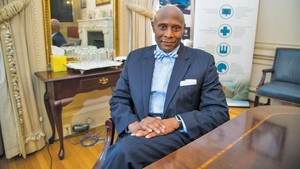 The founder and CEO of Bithgroup Technologies thought it was time to pivot into the renewable energy industry in 2009. Six years later, BITHENERGY is a fast-growing company involved in some high-profile solar energy projects in Maryland and across the country.
The founder and CEO of Bithgroup Technologies thought it was time to pivot into the renewable energy industry in 2009. Six years later, BITHENERGY is a fast-growing company involved in some high-profile solar energy projects in Maryland and across the country.
Wallace, 59, also does consulting and business education. He took some time at his company’s Mount Vernon headquarters to talk about his businesses, the rapid growth of solar energy, and the success of his pivot.
What can you tell us about your different companies? They’re separate companies. They’re all under the Bithgroup umbrella. You have BITHGROUP Technologies, which is IT, BITHENERGY which is renewable energy and energy management systems, and then you have consulting, the EntreTeach Learning Systems arm, which is more of an executive-coaching kind of company.
How did you build those different businesses? I’m an engineer by degree and background. I was with IBM for many years, Procter & Gamble, DuPont. Done the whole corporate thing. About 20 years ago, I started an IT company, Bithgroup Technologies.
What about the energy business? About six years ago I started another company called Bithenergy that does a lot of solar and wind work. What people don’t know is when I was studying engineering at the University of Pennsylvania, my area of research was solar energy. This is back in the 70s. The only problem was, when I got my degree, you couldn’t find a job in renewable energy. In 2007, 2008, we saw an opportunity now that the nation was ready to invest in new technology, particularly renewable energy technology. So right now we design and we build large-scale solar projects and do some smaller wind projects.
How did you get from an IT company to putting up solar panels? When we pivot, one thing we look at very closely is how risky or difficult will that pivot be? And one way to minimize risk or difficulty is to make it a shorter leap. Our first leap was into energy management information systems. Why? Because that’s what we do in the IT business. We manipulate data. A bit is a bit. A byte is a byte. Once we got that beachhead in the energy sector, we looked at where else we could penetrate that would be less risky. The next logical one was solar energy.
Will readers recognize any of your projects? In Howard County we have the largest solar array in the county. It’s a 10-megawatt plant. We said, versus doing one big 10-megawatt plant, let’s build five 2-megawatt plants. When we do it that way, I can bring in different customers.
What’s changed in solar energy over the past six years? The technology has accelerated. What used to cost me a dollar to build five years ago, six years ago, now costs me 20 cents to build. Efficiency has improved. What was maybe 40 percent efficiency, we’re now talking 60-70 percent.
Does that help you compete even as oil prices are low? We were concerned about fracking and the impact that would have [on energy prices]. But I can tell you, the hockey stick analogy — where you hit an inflection point and then growth becomes exponential — I believe in this industry we are either at that inflection point or close to it. And because of that, I believe even with fracking, even with the global price of oil being depressed, I believe we’re beyond the point of return.
What challenges did you have starting up in solar? When we started in this business, we spent a lot of effort and resources educating people, especially banks. We’d have a zillion meetings, no money. They were interested, but because it was new, they didn’t understand it. I began dealing with private equity investors. These were men and women who were quick, who could read the market pretty fast, and they got it. And I tell you who also got it: the utility companies. Utility companies have requirements to start producing more power from renewable energy sources.
What else are you doing that excites you? President Obama said, “I want my military bases around the world to diversify the sources of power generation they use to renewables.” The government put out an RFP to do that. We bid on that contract. We won as a sub to a big company, and we won as a prime to a small busines. The other thing that’s significant is we’ve built a number of solar plants on landfills and brownfields. Right now we’ve estimated there’s about 5,000 or so landfills, brownfields in the U.S. What would happen if we put solar in all of those places Landfills have no other use b esides solar. It’s pretty exciting.
Get Contact Information for Bithgroup Technologies, Inc. bithgroup.com

